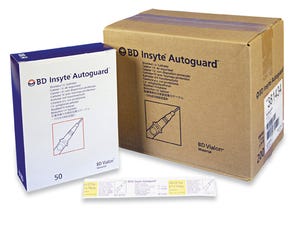BD Medical: injects innovation into packaging
January 30, 2014
 Daren Tuttle, principal packaging engineer for BD Medical, a segment of the global medical technology company BD (Becton, Dickinson and Co.), has been involved in the packaging industry for over two decades. In his current role, Tuttle designs, creates and improves packaging processes as well as investigates new materials and equipment for the Infusion Therapy Div. of BD Medical.
Daren Tuttle, principal packaging engineer for BD Medical, a segment of the global medical technology company BD (Becton, Dickinson and Co.), has been involved in the packaging industry for over two decades. In his current role, Tuttle designs, creates and improves packaging processes as well as investigates new materials and equipment for the Infusion Therapy Div. of BD Medical.
Tuttle is also the technical leader of BD Medical's Packaging Knowledge Group (PKG), a select segment of the BD Medical staff tasked with developing innovation in packaging technologies.
He serves as a member of the Packaging Management Council (PMC), an association of senior packaging managers from consumer and industrial goods manufacturing companies, facilitated by the Packaging Machinery Materials Institute (www.PMMI.org). PMMI also sponsors and produces PACK EXPO International 2008 (www.packexpo.com), being held Nov. 9 to 13 at Chicago's McCormick Place.
Packaging Digest recently spoke with Tuttle to learn more about his perspective on packaging and some of the more pressing issues affecting the industry today:
PD: How important is packaging to BD Medical?
Tuttle: Packaging is fundamental to BD Medical or any company that provides a product to customers. In the medical industry, packaging plays the role of ensuring product integrity, sterility and most importantly, quality. Packaging is also a means of providing dosage instructions and safety information to users. It is our job to develop packaging that exceeds consumer expectations. Whether it is visually appealing or user-friendly, packaging provides a means of promoting the product while keeping it safe.
PD: How does BD Medical approach the package development process?
Tuttle: Packaging is thought about from the moment of product conception—not as an afterthought. With so many tools at our disposal, package development is a combination of efforts on our part and the many internal and external resources available. Because the medical industry is heavily regulated, there is great importance placed on traceability and accountability.
|
The key driver for packaging automation is the |
PD: Consumer desires are a strong catalyst for packaging innovation. What are consumers looking for from packaging?
Tuttle: Having dealt with different study groups in my career, I have observed a host of things customers want from packaging. Their most important requirement is that packaging protects the product, maintains its quality and sterility and is easy to use. At the same time, customers are looking for new technology and innovation at a reasonable cost to them.
In the medical field, the most successful packages combine innovation, design appeal and familiarity. It is a 'previous use' type of market. Our customers are looking for products that they are already accustomed to whether it is the technology or the package itself.
PD: Sustainability is top of mind in the industry today. Do you think the issue has been well defined?
Tuttle: Generally, sustainability has been well defined in both the packaging and medical industries. Even the general public has an understanding of what it is. When we speak about sustainability in packaging we think green or earth-friendly, but it should also encompass safety. A package has to be safe and healthy for customers and the environment. The responsibility to continue to define the term and think of what is best for the customer, environment and the community is on the individuals and companies that produce the packages we use every day.
PD: Where do you see the biggest strides in sustainability being made? What are the biggest hurdles that still need to be overcome?
Tuttle: I think progress is most evident with the many sustainable material alternatives being integrated into packaging. With plastics being so hard to pass as 'sustainable,' the introduction of more bio-materials such as corn-based polymers and resins are beginning to direct the industry in the right way.
The biggest obstacle will be increasing the general knowledge across medical, packaging and consumer industries. While the issue has been well defined in general terms, there is still more to learn about the effects and future of the sustainability movement. One issue that comes to mind is material handling and what affects the changes will have on the industry as a whole.
PD: Automation is another trend growing by leaps and bounds. What do you think the drivers are behind this growth? What are end-users like BD Medical looking for from automation?
Tuttle: The key driver for packaging automation is the speed to which products are brought to market and assuring that they are of the highest quality. While this is slowly happening, the medical industry requires better inspection systems to be certain of the quality of a packaging product. As automation grows, packaging equipment manufacturers will need to assure the medical industry that products being produced retain their integrity consistently.
When BD Medical looks for automation, it is important that the partners we work with are reputable and provide first rate products. We have built our success on relationships with our packaging suppliers. We expect them to bring new innovations such as automation to us.
PD: What new or emerging technologies impacting packaging do you think will be important in the next few years?
Tuttle: There are several initiatives driving innovation, but for the medical industry, advances in packaging testing equipment will be key. This testing is specific to porous materials used for sterilization. While it is hard to detect sterile barriers, current movements within the industry are making the process increasingly fool-proof.
Select companies are presently testing products on a single item basis, but the movement is towards testing for 'total packaging integrity' on a mass level. While these technologies are specific to the medical industry right now, as we move towards testing for total package integrity, I can see it being used for other industries such as food.
An interesting issue that has taken center-stage in packaging is the 'RFID versus 2D barcode' discussion. While not an 'emerging technology,' RFID will steadily become an important component of the packaging equation. The issue for suppliers, however, will be to provide the most user-friendly technology which will help prevent fraud and mistakes with use. The true hurdle is finding a way to get everyone on board.
PD: What would you say are some of the opportunities and challenges facing the packaging industry over the next few years?
Tuttle: For medical device and pharmaceutical manufacturers, the use and interpretation of the governing document for sterilized packaging, ISO 11607, is going to change how we think about and create packaged products.
ISO11607 is meant to be a means of validating, verifying and designing packaging for the medical industry and creates an opportunity to get to the entire industry on the same page for quality and consistency. The difficulty remains in the fact that it the boundaries have yet to be set, which leaves it open to varied interpretations.
There's a lot of work being done to understand the regulations more intimately and assess what the opportunities and challenges will be. The fine tuning is going to be vital moving forward.
PD: When sourcing solutions for new products or packaging, what resources do you use?
Tuttle: There are three vital resources used at BD Medical to source solutions. The first is leveraging relationships with key suppliers and customers around the globe. Customers expect innovative technologies from us, so we expect the same from our suppliers. Our partners provide us with updates on emerging technologies that can better help us improve our products.
The next source is leveraging our employees. Within BD there are two groups that are vital to how we package our products. The first is the “Category Management Group” which is comprised of purchasing individuals at BD. Because they constantly deal with suppliers and customers, they provide us with new innovations for our packaging groups to see and try. The second group is the Packaging Knowledge Group (PKG) which represents professionals across all divisions and units throughout BD Medical. We are in constant contact and this continuous flow of ideas allows us to increase efficiencies and often not have to reinvent the wheel. If one area has looked at a product, material, equipment and/or process, we share the information and see if it will be pertinent to the area of business each of the members responds to.
The last source for solutions are the many different trade and industry publications as well as trade shows, which provide a place where individuals can see today's trends while visiting multiple companies see equipment and materials in one place.
PD: Can you describe BD Medicals' approach to packaging tradeshows?
Tuttle: BD takes a proactive approach to trade shows as they are a highly efficient way to source industry knowledge. Shows like PACK EXPO provide the opportunity to see the trends affecting packaging up close while interacting with exhibitors and industry experts in an intimate way.
Since PACK EXPO is so large, we typically utilize a buying-team strategy. Core team members are often our packaging, quality-assurance, purchasing and category-management groups. Prior to each show, the teams are briefed on specific goals, allowing each person to go in with a direction to focus their energies.
Following the show, teams are debriefed and the information gathered is presented to remaining team members.
The knowledge and information generated from industry tradeshows allows us to continually work toward enhancing our products and our packaging methods.
With new projects constantly in the works, we see the packaging industry from a variety of perspectives, which helps us to maintain our success within our industry.
You May Also Like



